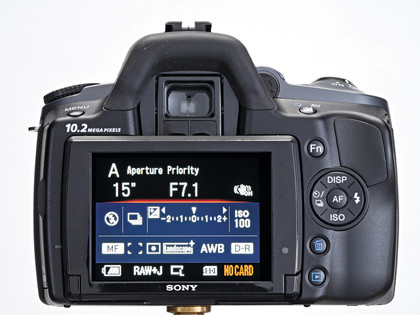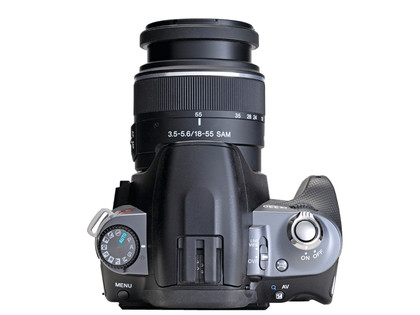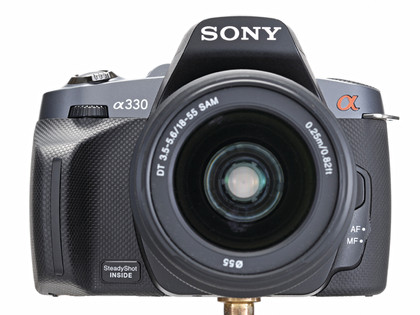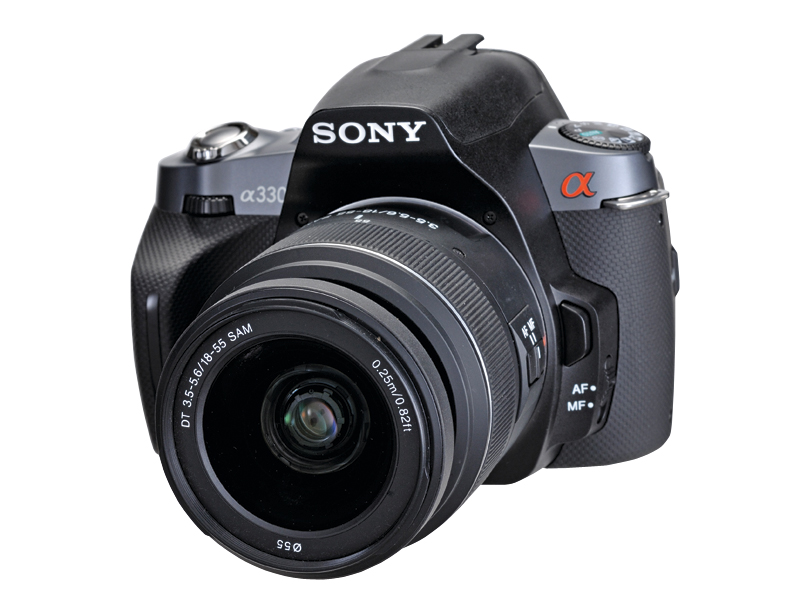TechRadar Verdict
The A330 is targeted at the first-time DSLR buyer and it has many features – Live View, on-screen help and Super SteadyShot among them – that will appeal. It will also appeal to more experienced users because it is great value, performs well and produces quality images
Pros
- +
Excellent performance and features
- +
Good handling and build
- +
Great value
Cons
- -
Awkward menu system
Why you can trust TechRadar
Sony's DSLR product range grew again recently with three more models, the A230, A330 and the A380 and it's the middle model, the Sony Alpha 330, which is exclusive to Jessops that we try here.
The A330 has a guide price of £500 with the standard 18-55mm f/3.5-5.6 zoom. At this price, it's pitched in a competitive sector of the DSLR market and will have to be good to make any impression.
Sony is proud of its fast AF Live View feature, judging by the tags and stickers that you come across when unpacking the camera. A switch on the top-plate gives the option of Live View or OVF (optical viewfinder). Select Live View and you're presented with a high-quality monitor image.

There's the option of having an uncluttered image, a live histogram showing or camera settings information. First touch of the shutter release and the AF whizzes into action, the image popping into focus. It's probably the fastest, most sure-footed Live View AF system that has been our pleasure to use.
Even in poor light or low contrast, the nine-zone AF system is efficient and the working sensor (or sensors) is highlighted in green. The monitor can be tilted for overhead or waist-level shooting and you get a clear image even when viewed obliquely. Fully press the shutter button down and the picture is taken. There's no final 'twitch' or 'hunt' that slows the process down like you get with some DSLRs.
Live View is one of the A330's big selling points, but there are plenty more. The on-screen help guide is one aimed at less experienced camera users and assists with the choice of exposure modes.
Another feature that will appeal to people new to DSLRs, but might make experienced photographers frown, is the digital Smart teleconverter. This feature is an in-camera cropping facility available in Live View and JPEG quality mode, magnifying the image by factors of 1.4x or 2x.
On the button
Much more useful is the Fn (Function button) that comes into play in P, A, S and M modes only. Push this and you get six options of Autofocus mode, Metering mode, White-balance, AF area, D-range Optimizer and Creative Style. This lets you fine-tine the camera's handling to your liking or to deal with the situation facing you.
D-range Optimizer has three settings – Off, Standard and Advanced – and is useful on contrasty light. Standard is a good default setting and makes a difference but the impact of the Advanced setting is amazing. In backlit situations, it brings out shadow details effectively without losing too much in the highlight areas. Certainly, it's worth using.

The same can be said of the Creative Style feature where there are seven options, again accompanied with on-screen help. This is where you can alter colour reproduction and includes a monochrome option.
The alterations are applied in JPEG quality mode only and in RAW you can always use the original image. In fact, using the supplied Sony software you can adjust RAWs using D-range Optimizer as well as Creative Styles.
Overall performance of the exposure system was impressive. It consistently delivered fine exposures and was difficult to fool. Only in extreme lighting did we experience duff exposures.
On occasion, it seemed that the camera underexposed according to the monitor but checking the histogram revealed that there was plenty of information across the full tonal range. There's an exposure bracketing function but this is limited to three shots in 0.3 and 0.7 EV steps. Given the choice, it would have made more sense to have the options of 0.5EV and 1EV.
Shooting steady
Assessing the actual benefit of camera shake systems isn't straightforward. Sony claims a 2.5 to 3.5 EV benefit with its Super SteadyShot that, in theory, means that you can shoot at 1/25sec or 1/10sec and get the same sharp pictures as you would at 1/125sec.
In practice, this claim appeared justified and we were even getting sharp handheld exposures as slow as 1/6sec – out of a sequence of four shots, two were sharp.

As regards to image quality, we found the A330 more than capable of producing files that can be readily enlarged to give A3 prints and beyond, especially at ISO 400 and lower. Go to ISO 1600 and 3200 and noise is more significant.
We did a comparison with the recently launched Pentax K-7 (admittedly, a more expensive camera) and found the A330 has higher noise levels from ISO 800 upwards. Below this, however, image quality is comparable which is a credit to the A330.
Handling rates highly once the camera is set up. In principle, Eye-start makes sense and the idea of the camera preparing itself for photography as it's brought up to the eye is good. However, it is annoying that the camera with Eye-start on the AF twitches away as you carry it around your neck.
If you want to shoot fast action, you should have no problem with the A330's shooting speed. With a Sandisk Extreme 4GB, we got 100 RAWs before the camera showed signs of slowing down.
There's no automatic sensor cleaning function and you have to do this through the menu. The camera emits a high-pitched buzz and vibrates for an instant while cleaning takes place. It seems to work well, though, because over the 400 exposures made for this review, none showed any sign of dust or hairs.
Follow TechRadar Reviews on Twitter: http://twitter.com/techradarreview
